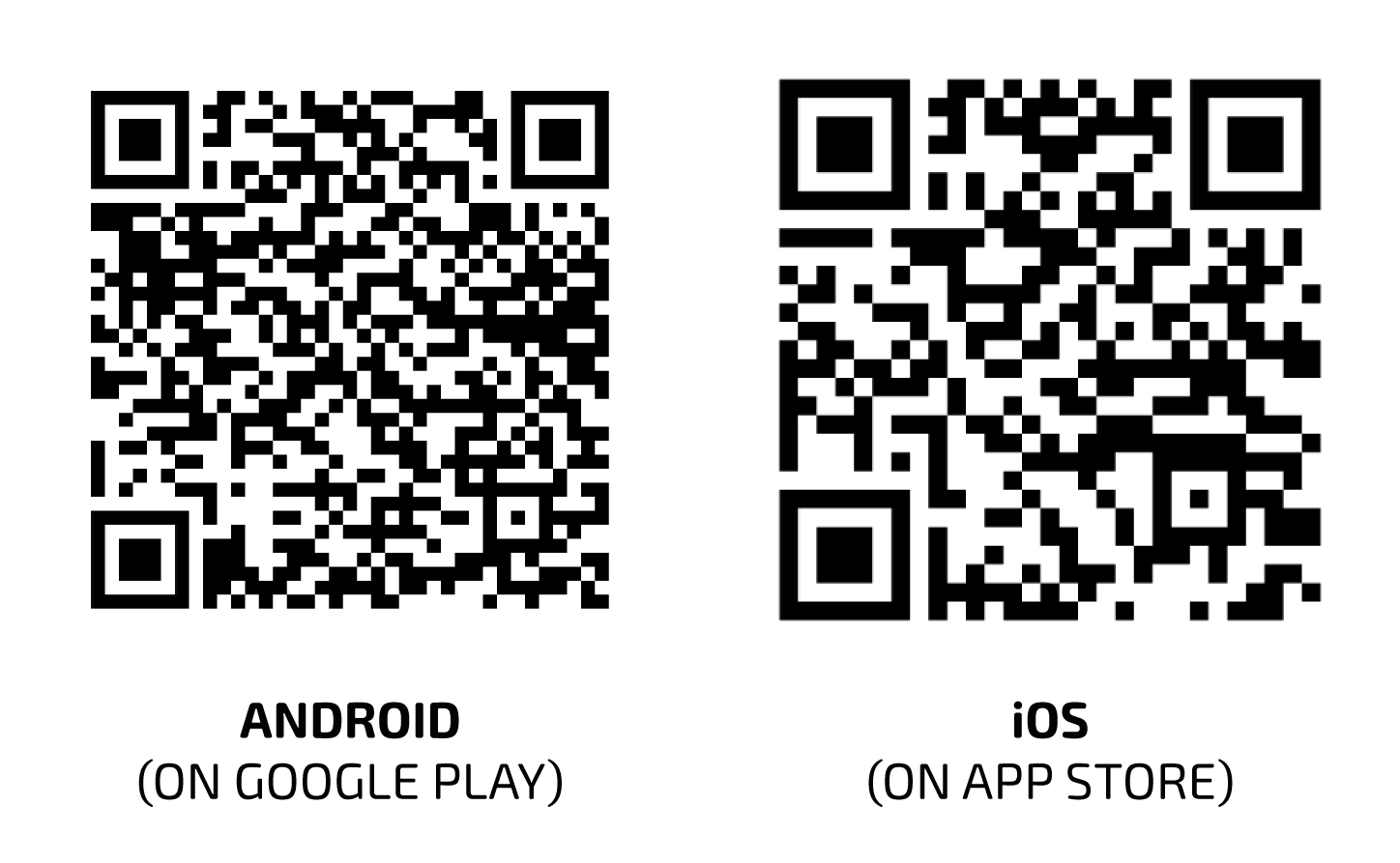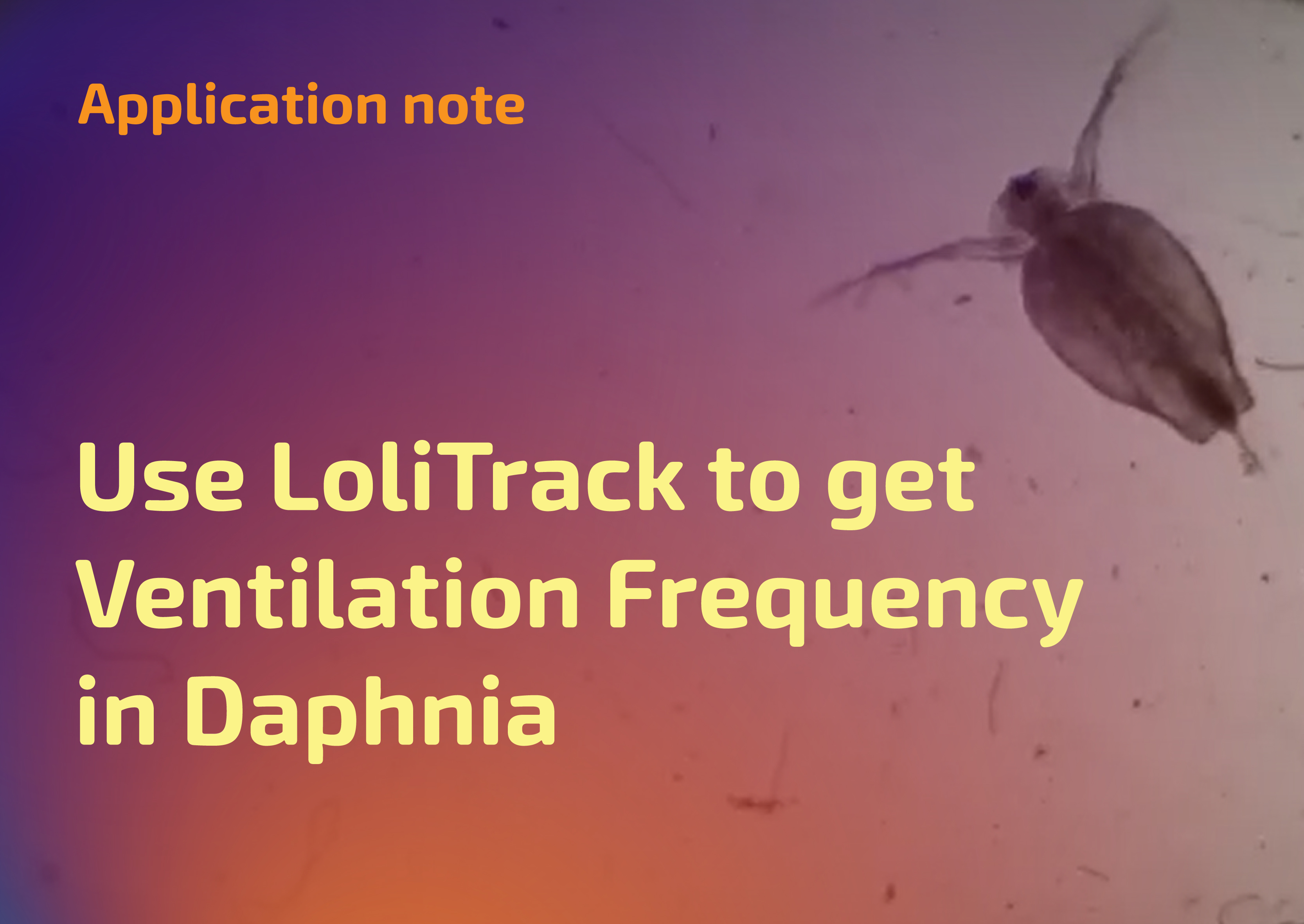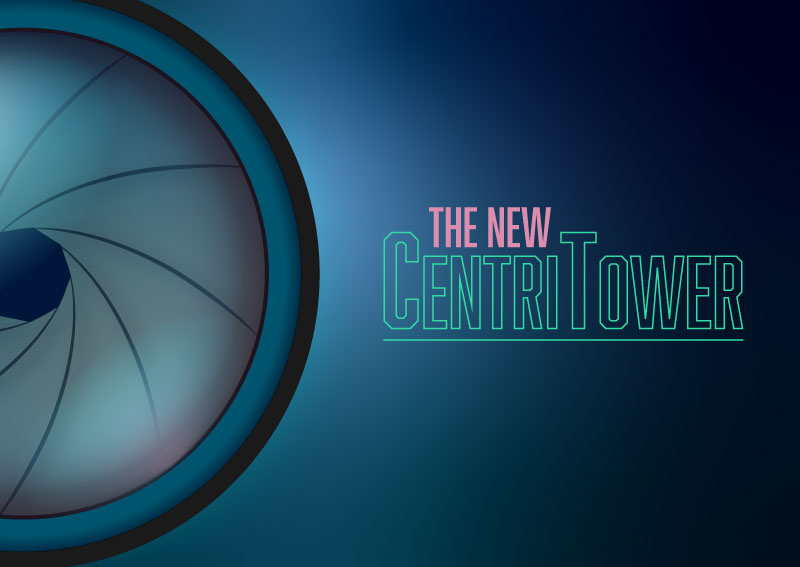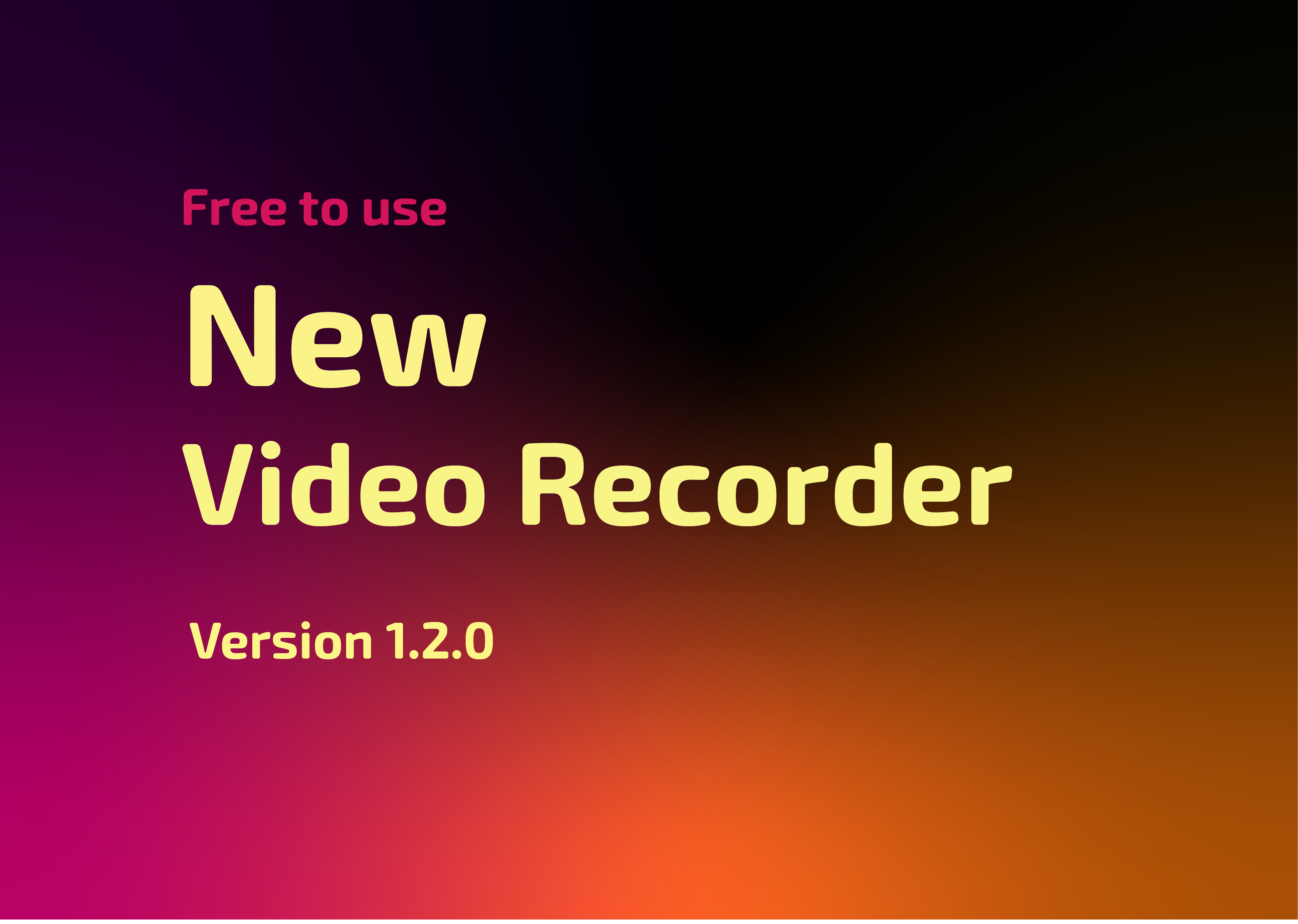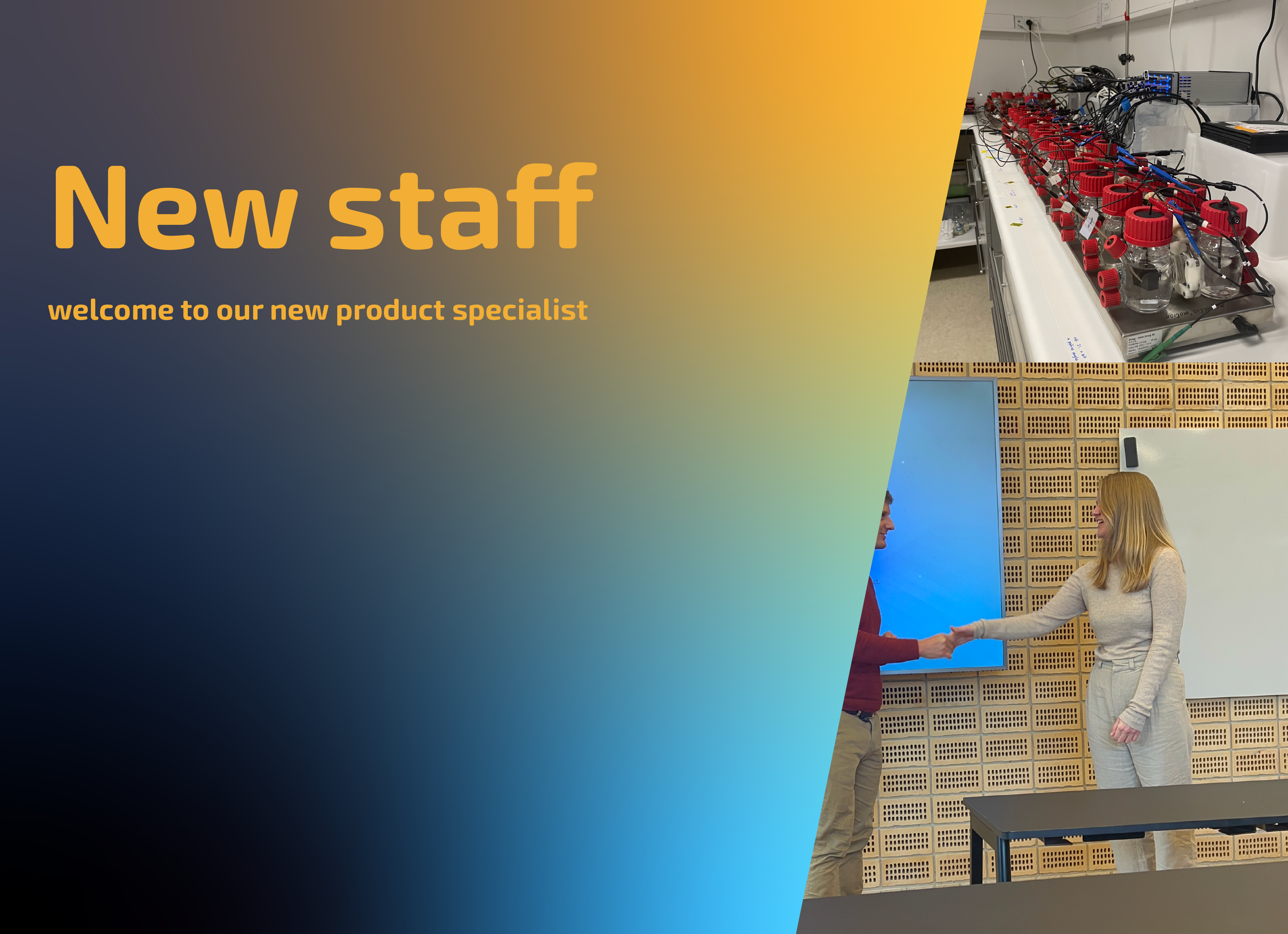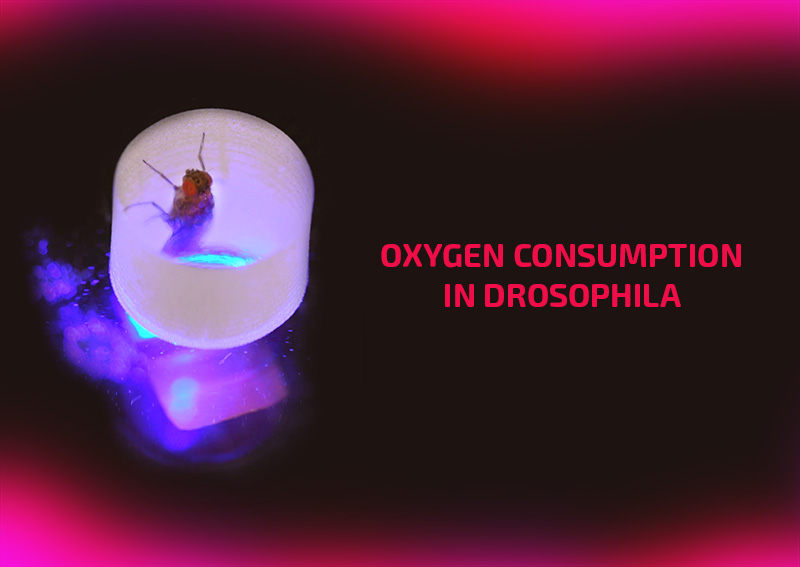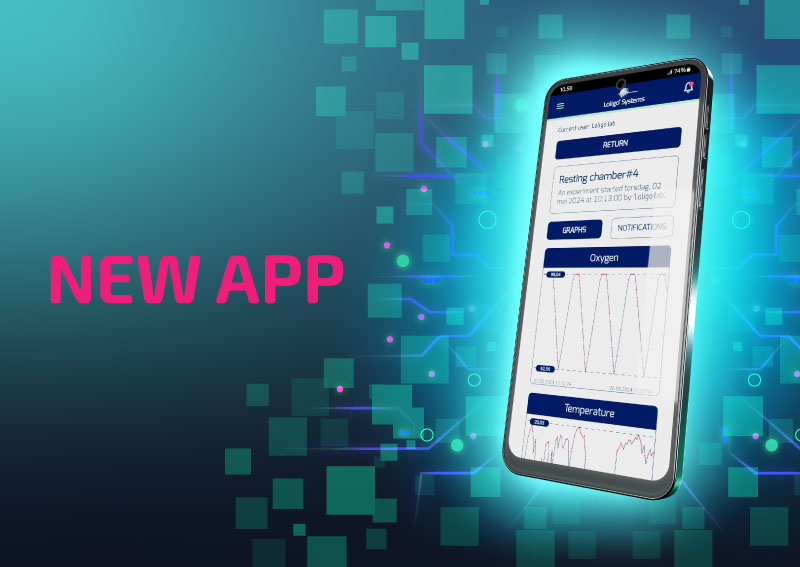News
Mon, Dec 15 2025
Christmas Holiday
Our office will be closed for the Christmas holidays from December 23 to 28 and from December 31 to January 4.
We wish everyone a lovely holiday season!
The Loligo® team
Thu, Oct 09 2025
Respiration by microorganisms in suspension
The microplate respirometry system already have a long and well proven track record for providing high throughput oxygen consumption measurements in a range of different small organisms (e.g., Daphnia, Zebrafish embryos, marine invertebrate larvae, etc.).
In this application note, we demonstrate how the microplate system can also be applied for high throughput respiration measurements of microorganisms in suspension, here in corrosion samples dominated by the bacterium Acidithiobacillus thiooxidans.
Sulfide oxidation by A. thiooxidans at low pH can lead to the production of sulfuric acid, which is very problematic for concrete corrosion.
H2S+ 2O2 → H2SO4 (sulfuric acid)
As the sulfide oxidation is driven by an O2 reduction and consumption, this process can be investigated by following the change in O2 over time with the use of the microplate respirometry system.
The aim in this setup and demonstration was to investigate the inhibitory effect of nitrite on this sulfide oxidation under low pH (~ 2) in samples of concrete corrosion materials, using the microplate respirometry system.
Approach
Corroded concrete material, softened and structurally deteriorated as they have been exposed to microbial induced corrosion (expected to be dominated by A. thiooxidans), was mixed with water, sulfuric acid, sulfide and with different concentrations of nitrite (NaNO2). The samples were vortexed to mix and aerate the samples before being distributed across the glass microplate with 1,700 µL wells. To support continuous agitation, one glass bead was included in each well before the wells were filled with sample solution and sealed, and the plate and reader were placed on an orbital rotating shaker table.
After this, the change in the oxygen saturation in the 24 wells (with different nitrite concentrations) was monitored and logged using the MicroResp software. Below is an image of the results/output in the MicroResp software. The first column is the control wells (no nitrite added), and each of the subsequent columns are wells with increasing nitrite concentrations. The unit mg/L refers to mg NO2--N / L, which represents the concentration of the added nitrogen (N) in the form of nitrite (NO2-) in the samples.

These results clearly show that O2 consumption decreased with increasing nitrite concentration. In control wells and wells with lower nitrite concentrations, most O2 was consumed within one hour. For the highest nitrite concentrations, only limited O2 was consumed within one hour. These results demonstrate an inhibitory effect of increasing nitrite concentration on microbial oxygen consumption, and thus, that this microbial activity could be evaluated using the microplate system.
Based on the MicroResp data output, a figure like this can be created:

Figure created based on the MicroResp analysis software output. Well D1
excluded due to a trapped air bubble reoxygenating the sample.
This data output could be used to create dose response curves, here based on the first 30 minutes of monitored oxygen consumption:

Inhibition of oxygen consumption compared to controls (without added nitrite) at increasing
nitrite concentration after the first 30 minutes. Values are average of the four replicates ± 1 SD.
The microplate system was also used to investigate microbial oxygen consumption over a longer time frame, here for about 6 hours:

These experiments were carried out as a part of the master’s thesis work by Sune Popp Hinke and Line Gade Frahm together with Associate Professor Asbjørn Haaning Nielsen at the Department of the Built Environment, Aalborg University. A big thanks to all for testing our system to monitor microbial oxygen consumption.
Further insights on the project and challenges associated with acid formation, by Professor Asbjørn Haaning Nielsen:
This application note demonstrates how a microplate-based respirometry system can be used for high-throughput measurements of microbial respiration in concrete samples undergoing biogenic sulfuric acid (BSA) attack. Such environments are typically colonized by the acidophilic, sulfur-oxidizing bacterium Acidithiobacillus thiooxidans, a key driver of BSA.
At the low pH characteristic of BSA-affected concrete surfaces, A. thiooxidans oxidizes hydrogen sulfide (H₂S) to sulfuric acid (H₂SO₄):
H2S+2 O2 → H2SO4
The acid aggressively dissolves the calcium-rich cement matrix, forming gypsum and ettringite whose expansion leads to cracking and loss of structural integrity. The microplate system enables rapid, parallel monitoring of oxygen consumption, providing high-resolution insight into sulfur-oxidizing activity directly in BSA-affected concrete. In the present study, we examine how nitrite inhibits the BSA process by reducing the sulfur-oxidizing activity of A. thiooxidans and thereby slowing sulfuric acid generation.
If you too are interested in the microplate respirometry system for oxygen consumption rate measurements in suspensions of bacteria, algae, yeast, protozoa etc., please reach out to our product specialist Dr Louise Vinther Grøn (lvg@loligosystems.com), who will be happy to discuss your experimental needs and considerations.
We are looking forward to seeing even more studies on microbial oxygen consumption with the use of the MicroResp system in the future.
Mon, Sept 01 2025
LoliTrack v5 Frequency Analyzer to Quantify Ventilation Frequency in Daphnia
Our video tracking and behavior analysis software LoliTrack v5 offers a range of different features to study animal movements and behavior. This includes tools to analyze and quantify frequencies in video images, e.g., Zebrafish heart rate, fish tail beat frequency, gill ventilation, insect stridulation, etc.
Here, we demonstrate how quick and easy it is to track and analyze the ventilation movements in a Daphnia:
We thank you Rorisang Malatsi and Dr Tarryn Lee Botha from the Department of Zoology at University of Johannesburg, for sharing the excellent video recording.
In these few steps, important physiological parameters such as thoracic limb activity, heartbeat rates and other pulsing movements in Daphnia or other small or large organisms can be quantified.
If you have videos showing stable pulsing movements, LoliTrack can quantify them.
For even more details on the automated frequency analysis tools of LoliTrack, see our video guide: LoliTrack 5 - How to use the Frequency analysis tool. This guide includes examples of quantification of heartbeat rate and estimation of stroke volume by a mahi mahi larvae and tail beat frequencies from the Brazilian fish Brycon amazonicus.
If you are interested, but unsure whether the software can analyze the frequency of your specific organism or target and video, please feel free reach out to our product specialist, Dr Louise Vinther Grøn. She will be happy to perform test analysis on your specific video in the software and help you evaluate the possibilities.
Tue, Aug 12 2025
New high precision system for well plate filming

Enter the CentriTower system, a cutting-edge optical telecentric lens system designed to deliver high-resolution video images with zero parallax error and zero lens distortion. This innovative and compact system is perfectly suited for filming in PCR plates, deep well plates, petri dishes, and similar-sized vessels.

Researchers can now analyze the behavior of tiny, fast-moving organisms such as fish larvae, Daphnia, copepods, and Drosophila with exceptional clarity and precision. The system includes a 5 MP USB 3 camera with a C-mount, capable of capturing videos at up to 75 frames per second (FPS), ensuring that no detail is missed.

One of the standout features of the CentriTower system is its ability to block ambient lighting, thanks to its durable yet transportable tower design. This ensures consistent and reliable results by eliminating reflections and enhancing contrast. Additionally, the system includes an infra-red light panel for back illumination, which further improves video tracking performance without affecting the behavior of the test organisms.
The CentriTower system seamlessly integrates with our automated video tracking and behavior analysis software, LoliTrack v5 – a powerful combination of hardware and software allowing researchers to track and analyze behavior in small animals with ease.

As the scientific community continues to push the boundaries of knowledge, the CentriTower system stands out as a vital tool for researchers seeking to gain deeper insights into the intricate behaviors of the natural world. With its top-quality optical components and user-friendly design, the CentriTower system is set to become an indispensable asset in laboratories around the globe.
The CentriTower can be bought as a separate product or as a system that includes LoliTrack v5 and an IR light panel.
Mon, Jul 28 2025
New Update – Video Recorder Version 1.2
We have released an updated version of our free Video Recorder software for recording and editing video files.
New features and improvements:
You can now adjust the video camera exposure time directly in the software. This is a great help when using various light panels for back illumination, e.g., as with our CentriTower system.
Another new feature is the ability to change the frame rate for two synchronized video cameras (e.g., for 3D tracking), rather than just for one at a time. Synchronized video files are now exported with distinct/different names, so that you can use them for 3D tracking, e.g., in LoliTrack.
You can download the latest version here:
The software continues to support most video cameras but offers more functionality if using our video cameras from IDS Imaging in Germany.
Please note that this version of Video Recorder is not compatible with the older uEye video cameras from IDS Imaging.
Sun, Jun 01 2025
Summer Holiday
Our office will be closed for the summer holiday from 12th - 27th of July (both days included).
We wish everyone a lovely summer!
The Loligo® team
Wed, Apr 02 2025
Welcome to our new product specialist
We are happy to welcome and introduce our new product specialist, Louise Vinther Grøn, to the Loligo Systems team. We have said goodbye to Andreas Mørck, who after 8 years in this position is moving to a new position in a biotech company. We thank him for all his great work here at Loligo Systems and wish him all the best of luck in his new job!
Louise joins our team from Aarhus University, where just last week she successfully defended her PhD in Biological and Chemical Engineering. During her PhD studies, Louise worked with acetogenic microorganisms in bioelectrochemical systems. From this work, she has a strong background in the integration of measurement and sensor technologies into specialized systems to investigate biological processes, and before that, an educational background in Biology. Building on this experience, Louise will now provide our customers at Loligo Systems with valuable, efficient and free support on our systems – as we have always offered.
With her background in microbiological systems, Louise will also explore how our measurement systems can be applied for microbial oxygen consumption and respirometry. If you are curious about the possibilities of using our systems for your microbiological experiments, please reach out to Louise!
Fri, Nov 15 2024
New Job Opportunity
Product Specialist with a flair for technology and a passion for bio sciences
Do you want to work with leading technologies for measuring respiration and behavior in animal models such as Zebrafish, Daphnia, and other aquatic organisms? Do you have a background in biology, biotech, biochemistry, or environmental engineering, and are you passionate about measurement technology, technical support, and the development of advanced equipment? If so, the role of Product Specialist at Loligo® Systems could be your next career step.
About the Position
As a Product Specialist at Loligo® Systems, you will be a key figure in our company and have a unique opportunity to work with researchers and students from universities worldwide. Building on your academic background in biology, biochemistry, or related fields—ideally with a Ph.D. or equivalent—you will provide guidance on using our advanced measurement equipment, participate in testing, and developing existing and new products, and be responsible for documentation in the form of web content, technical drawings, illustrations, and more.
Your Primary Responsibilities:
- Technical support for customers via email and Teams/Zoom
- Development and updating of web content and product descriptions in our CMS system (Umbraco)
- Documentation and illustration of technical drawings and product functionalities
- Participation in international conferences and trade shows
- Contribution to product development, testing, and quality control
After thorough training on our systems and products, you will have the opportunity to shape the role based on your strengths and interests. You will report directly to the owner-manager and take on a central role in a small company, where you can influence development and become a key figure with management responsibility.
Who You Are:
- You have a relevant educational background, preferably with a Ph.D. in biology, biochemistry, biophysics, or related engineering fields, and a strong interest in measurement methods and innovation
- Experience from research environments or previous work with measurement equipment is an advantage, and you feel comfortable in a role with direct customer contact.
- You thrive in a varied workday, where you can focus on tasks related to technical documentation and quality assurance, while also providing efficient support to researchers globally via email and e-meetings
- You have strong language (English) skills, both written and verbal, and communicate clearly and precisely, whether with researchers, students, or professionals from diverse cultural backgrounds
- You are systematic and quality-oriented, with a natural curiosity about how technology can support research. Experience with CMS, CAD, or other digital systems is an advantage
We Offer
At Loligo® Systems, you’ll be part of a small, dynamic team with high professional standards, where innovation and technical development are the focus. As a Product Specialist, you’ll work in a specialized environment that provides solutions to a global customer base of researchers and universities who expect precision, deep insight, and high quality in all technical support. Our clients are knowledge-intensive experts in their fields, and they greatly value the high standard and technical consultation we offer.
At Loligo® Systems, you have the chance to quickly take on responsibility and make a noticeable difference in developing groundbreaking solutions for the research community. We work in modern facilities in Viborg—just a two-minute walk from the train station—with a canteen and health schemes that support a positive work environment. We also offer an attractive compensation package with health insurance and pension benefits, and we place a high priority on individual professional development and engagement.
Application
Career | a JKS company is handling the recruitment process. If this position sounds like the perfect match for you, we would love to hear from you! Please send your CV and a brief, motivated application with relevant attachments via the "Apply now" button below. We review applications on an ongoing basis, so feel free to apply today.
If you have any questions that are not covered in the job listing, please feel free to contact Chief Consultant Anne-Marie Hviid Ekstrøm at +45 3085 1294.
Please note that applications sent directly via email will not be processed or answered due to GDPR regulations.
Link to application: https://tinyurl.com/34cbhssc
LinkedIn post: https://tinyurl.com/5anhk4s7
Facebook post: https://fb.watch/vREf4iaTh6/
Thu, Jun 13 2024
How to measure respiration rates in Drosophila
In this article, we showcase how the microplate respirometry system provides an easy to use, high throughput respirometry tool for determining oxygen consumption rates in various life stages of terrestrial insects, here using fruit flies (Drosophila melanogaster and Drosophila littoralis). The project was performed at Aarhus University in Denmark in collaboration with Prof Jesper G. Sorensen at Aarhus University in Denmark.
The first part of the project looked at the respiration rates in eggs, third instar larvae, and pupae of D. melanogaster. The fruit flies were maintained at 19 °C, and were in the following life stages:
- melanogaster eggs: 0-12 hours old
- melanogaster larvae: 6-7 days since egg stage
- melanogaster pupae: 8-9 days since egg stage
The first trial had 10 x eggs + 10 x pupae (+ 4 x blanks). The eggs and pupae were transferred directly from their food solution/colony and placed individually in a well in the 80 µl glass microplate. The wells were then closed using gas-tight non-toxic sealing film, and placed onto the microplate reader. The microplate reader and glass plate were then covered with an opaque plastic box, to prevent ambient light from interfering with the optical oxygen sensor inside each well, and left at room temperature (21 °C). Here is a picture of the setup:
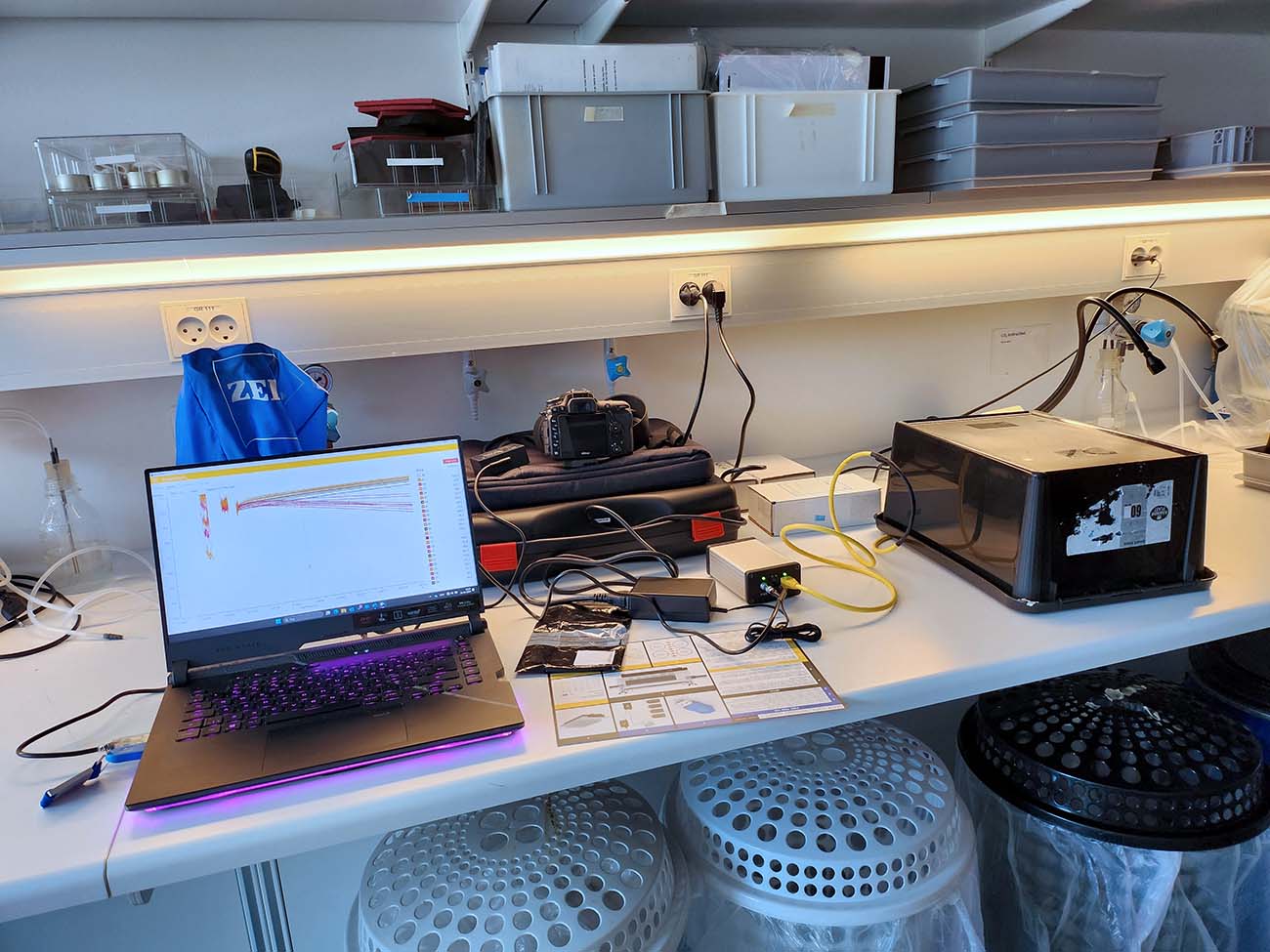
The MicroResp™ v1.1 software was used to calibrate the oxygen sensors, set up the plate and experiment settings, and to log data. Here are the exported data graphs:
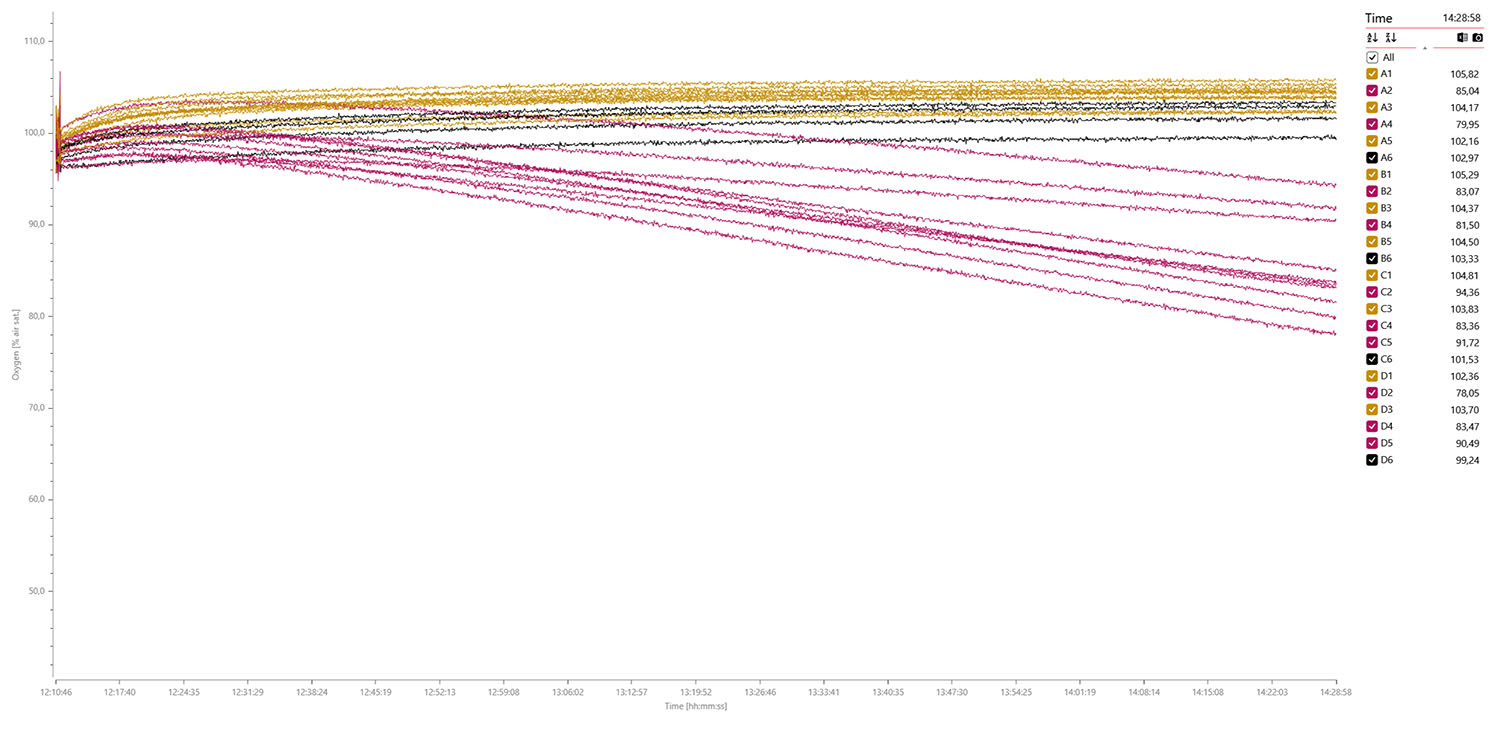
Oxygen data graph for 10 x eggs (dark golden), 10 x pupae (purple), and 4 x blanks (black) measured over 2 hours and 18 min.
The next trial used 20 x third instar larvae (dark cyan) and 4 x blanks (black), and data was logged for 1 hour and 35 min.:
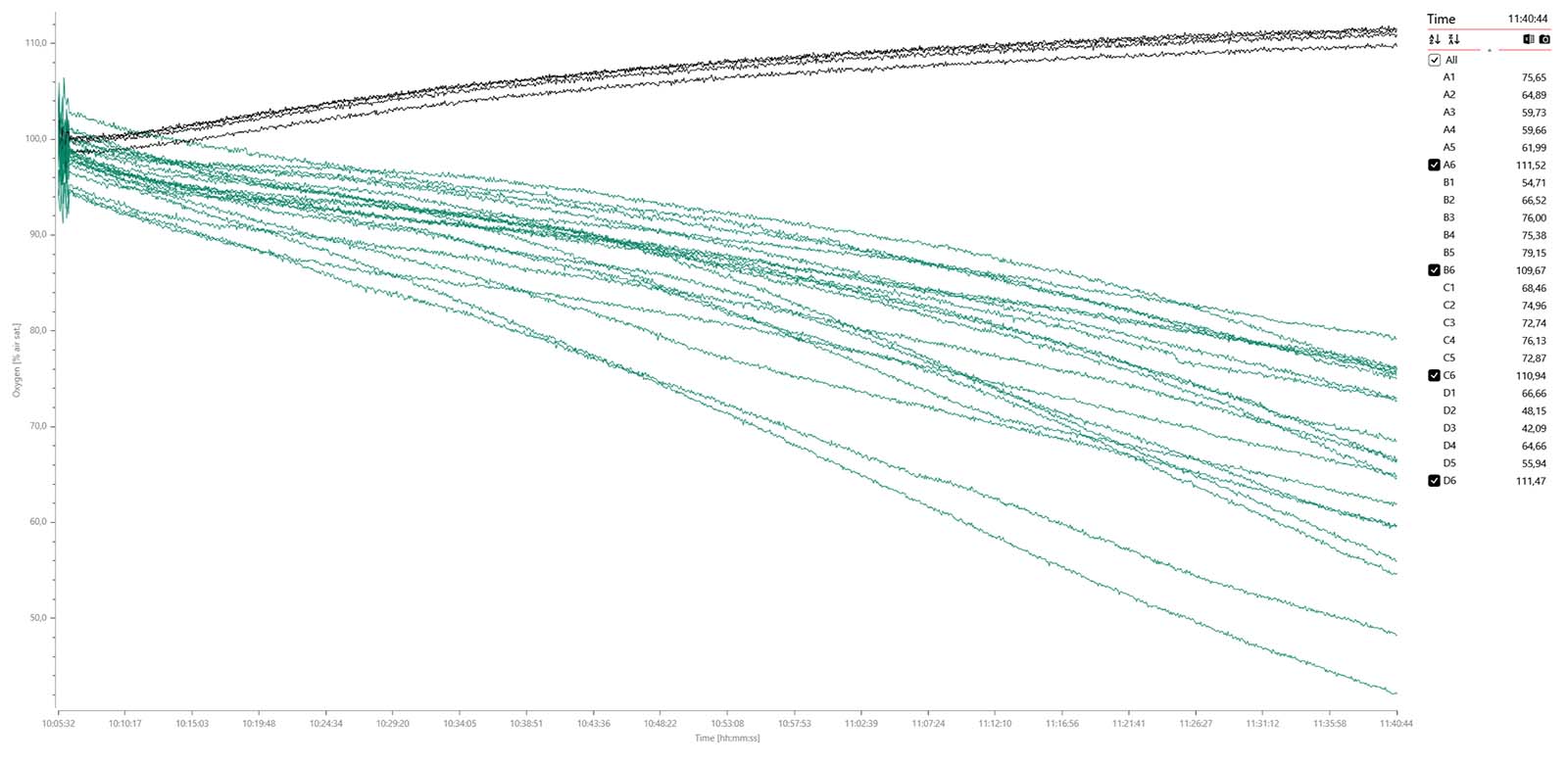
A data plot of the MO2 values shows oxygen consumption rates in the pupae (second from right) and larvae (first from right) but no consumption was detected in the eggs and blanks (far left):
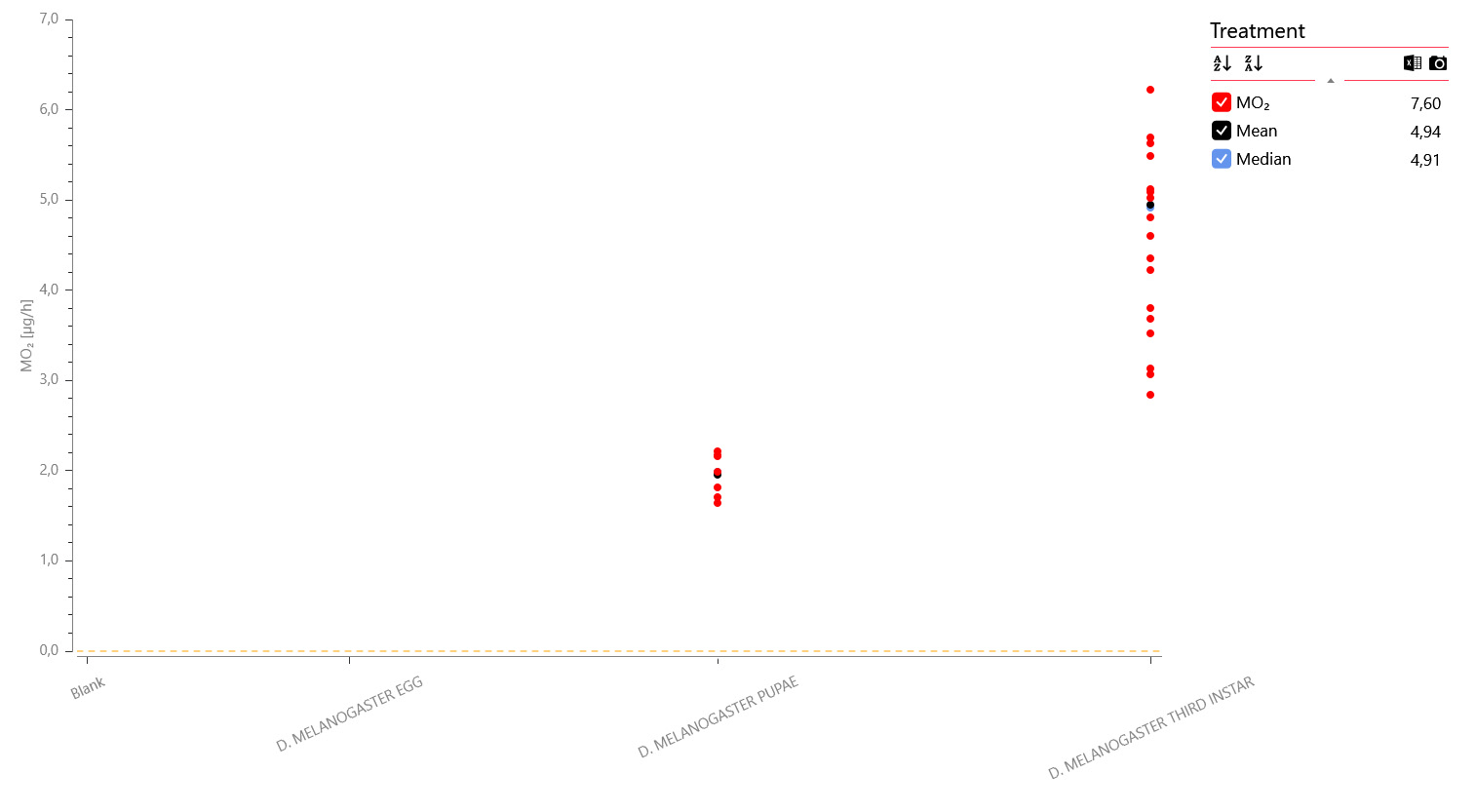
The next part of the project investigated the respiration rates in adult fruit flies, here D. littoralis. Besides determining the oxygen consumption rates of adult individuals, we also wanted to look at the effects on MO2 from anesthetization with CO2 – a common anesthetic used when handling live fruit flies. An individual adult fruit fly was transferred using an aspirator tube from their maintenance chamber at 21 °C and then directly into a well or anesthetized for 30 sec. with CO2 prior to transfer. The 200 µl glass plate was then closed with sealing film and placed under a box.
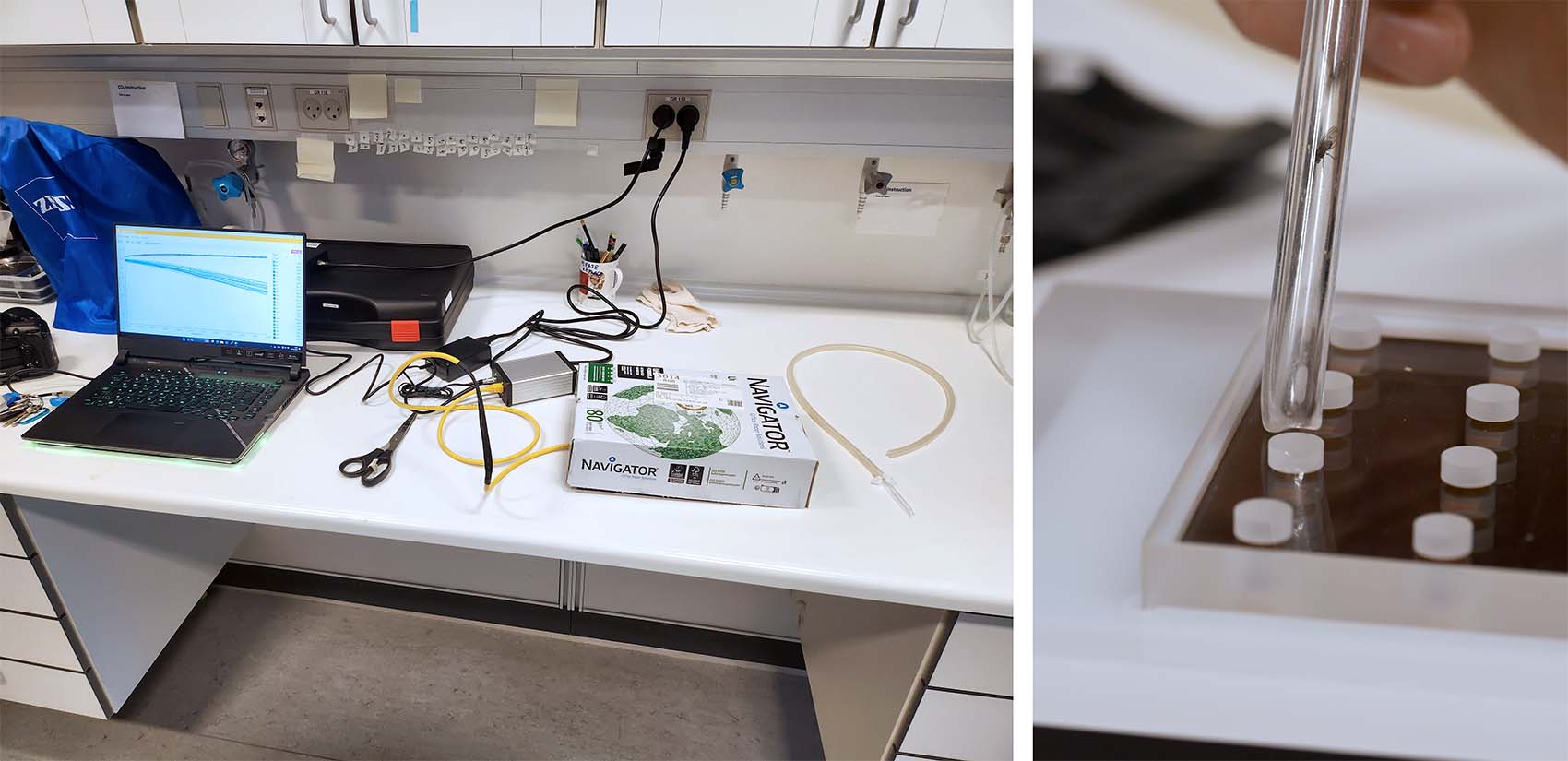
The MicroResp™ v1.1 software was used to calibrate the oxygen sensors, set up the plate and experiment settings, and to log data. Here are the exported data graphs:
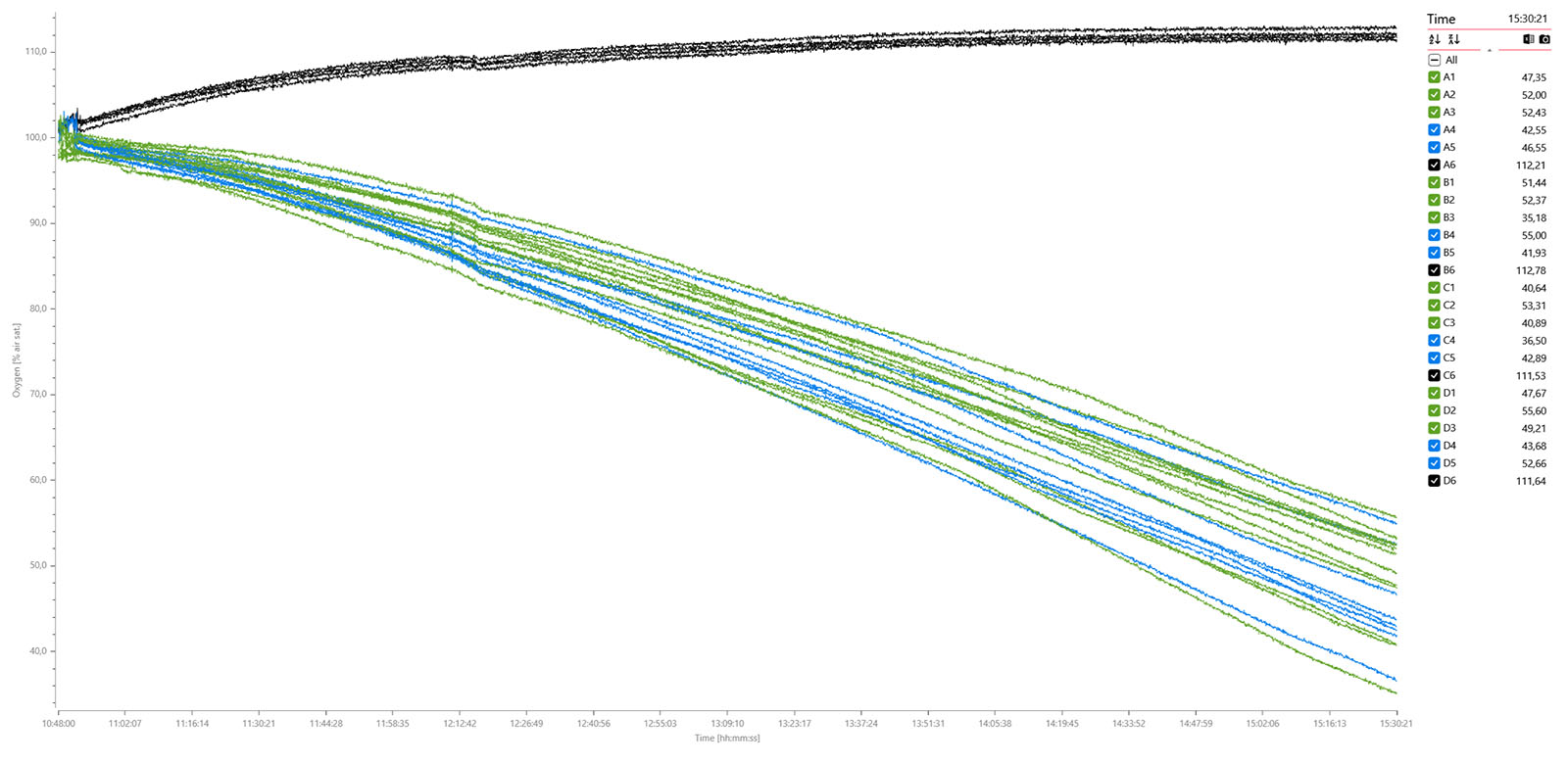
Oxygen data graph for 12 x adult flies (green), 8 x adult flies anesthetized with CO2 (blue), and 4 x blanks (black) measured over 4 hours and 41 min. A data plot of the MO2 values shows no apparent difference between non-anesthetized (mid) and anesthetized individuals (right):
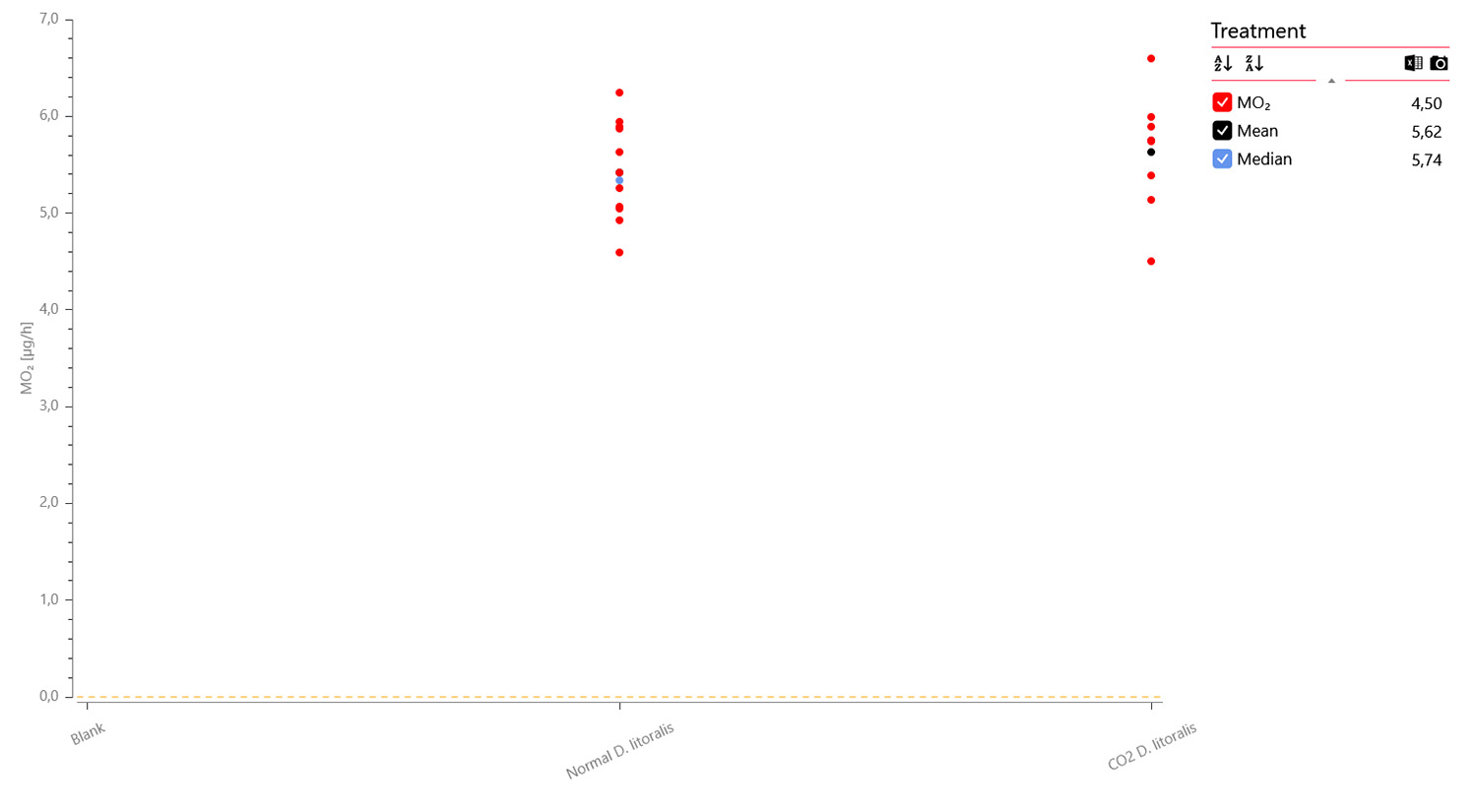
In conclusion, the microplate respirometry system was able to dertemine oxygen consumption rates in various life stages of fruit flies in a relative short period of time.

Want to learn more about the microplate respirometry system?
Wed, May 29 2024
Introducing the new LoliGO App
We are excited to offer users of Loligo® software this new free and useful tool.
The LoliGO App is a smartphone application for Android and iOS that allows users to remotely monitor their experiments while having the option of getting push notifications in case of power outs in the lab, computer failures, or alarms based on water quality thresholds – like if the temperature gets critically high in your respirometry chambers.



The LoliGO App uses a secure cloud-based service to handle data sent from the Loligo® software and to the App. Users can set up a user profile, and multiple users can access the same user profile at the same time (if they know the password!) aka you can have a shared lab profile.
You cannot alter or stop experiments from the app, and you cannot export or otherwise gain access to the raw data from the app. Completed experiment data will be automatically deleted from the app after 14 days.
The LoliGO App is free to use, and is currently compatible with AutoResp™ v3, and the app will be available with future updates of other Loligo® software soon.
Download the latest version of the LoliGO App:
- LoliGO for Android (on Google Play)
- LoliGO for iOS (on App Store)
